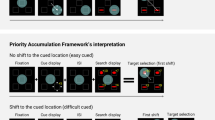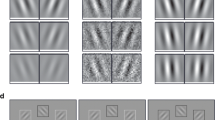Abstract
Five experiments are presented, providing empirical support of the hypothesis that the sensory phenomenon of lateral masking may explain many well-known visual search phenomena that are commonly assumed to be governed by cognitive attentional mechanisms. Experiment I showed that when the same visual arrays are used in visual search and in lateral masking experiments, the factors (1) number of distractors, (2) distractor density, and (3) search type (conjunction vs disjunction) have the same effect on search times as they have on lateral masking scores. Experiment II showed that when the number of distractors and eccentricity is kept constant in a search task, the effect of reducing density (which reduces the lateral masking potential of distractors on the target) is to strongly reduce the disjunction–conjunction difference. In experiment III, the lateral masking potential of distractors on a target was measured with arrays that typically yield asymmetric search times in visual search studies (a Q among Os vs. an O among Qs). The lateral masking scores showed the same asymmetry. Experiment IV was a visual search study with such asymmetric search arrays in which the number of distractors and eccentricity was kept constant, while manipulating density. Reducing density (i.e., reducing lateral masking) produced a strong reduction of the asymmetry effect. Finally in experiment V, we showed that the data from experiment IV cannot be explained due to a difference between a fine and a coarse grain attentional mechanism. Taken together with eye movement data and error scores from experiment II and with similar findings from the literature, these results suggest that the sensory mechanism of lateral masking could well be a very important (if not the main) factor causing many of the well-known effects that are traditionally attributed to higher level cognitive or attentional mechanisms in visual search.











Similar content being viewed by others
Notes
It should be noted that this concept of conspicuity refers to a relation between an object and its surroundings, i.e., to the degree to which it is embedded in its surroundings. As such it is distinct from the concept of visibility, which refers to properties of the object itself, like its color, size, etc.
For the other search experiments mentioned in this paper, we do report on error data and could thus test for speed accuracy trade off artifacts. However, no separate analysis is made of the type of errors (e.g., misses vs false alarms). The experiments were not designed to gather the kind of error data which could be used to test possible hypotheses (e.g., from signal detection theory) that have no relevance to the predictions investigated.
This 50% target absent/present ratio differed from the 20–80% target absent/present ratio used in experiment I, because this percentage was used by Cohen and Ivry (1991) as well. Other ratios would have made comparisons with their results less valid.
References
Bouma H (1970) Interaction effects in parafoveal letter recognition. Nature 226:177–178
Brainard DH (1997) The psychophysics toolbox. Spat Vis 10:433–436
Butler BE, Currie A (1986) On the nature of perceptual limits in vision; a new look at lateral masking. Psychol Res 48:201–209
Cameron EL, Tai JC, Eckstein MP, Carrasco M (2004) Signal detection theory applied to three visual search tasks—identification, yes/no detection and localization. Spat Vis 17(4–5):295–325
Carrasco M, Frieder KS (1997) Cortical magnification neutralizes the eccentricity effect in visual search. Vision Res 37(1):63–82
Carrasco M, Evert DE, Chang E, Katz SM (1995) The eccentricity effect: target eccentricity affects performance on conjunction searches. Percept Psychophys 57(8):1241–1261
Carrasco M, McLean TL, Katz SM, Frieder KS (1998) Feature asymmetries in visual search: effects of display duration, target eccentricity, orientation and spatial frequency. Vision Res 38(3):347–374
Chen CC, Tyler CW (2002) Lateral modulation of contrast discrimination: flanker orientation effects. J Vis 2:520–530
Cohen A, Ivry RB (1991) Density effects in conjunction search: evidence for a course location mechanism of feature integration. J Exp Psychol Hum Percept Perform 19(4):891–901
Cornelissen FW, Peters EM, Palmer J (2002) The EyeLink Toolbox: eye tracking with MATLAB and the Psychophysics Toolbox. Behav Res Methods Instrum Comput 34(34):613–617
Egeth HE, Santee JL (1981) Conceptual and perceptual components in interletter inhibition. J Exp Psychol Hum Percept Perform 7:506–517
Engel FL (1976) Visual conspicuity as an external determinant of eye movements and selective attention. PhD Thesis, Techninal University of Eindhoven, The Netherlands
Estes WK (1982) Similarity related channel interactions in visual processing. J Exp Psychol Hum Percept Perform 8:353–382
Findlay JM (1997) Saccadic target selection during visual search. Vision Res 37(5):617–631
Frens MA, Van der Geest JN (2002) Scleral search coils influence saccade dynamics. J Neurophysiol 88:692–698
Geisler WS, Chou KL (1995) Separation of low level and high level factors in complex tasks: visual search. Psychol Rev 102(2):356–378
Huckauf A, Heller D, Nazir TA (1999) Lateral masking: limitations of the feature interaction account. Percept Psychophys 61(1):177–189
Itti L, Koch CA (2000) Saliency-based search mechanism for overt and covert shifts of visual attention. Vision Res 40:1489–1506
Itti L, Koch C (2001) Computational modelling of visual attention. Nature Neurosci 2:194–203
Klein R, Farrell M (1989) Search performance without eye movements. Percept Psychophys 46(5):476–482
Kooi FL, Toet A (1999) Conspicuity: an efficient alternative for search time. In: Gale AG, Brown ID, Hasslegrave CM, Taylor SP (eds) Vision in vehicles VII. Elsevier, Amsterdam, pp 451–462
Kooi FL, Toet A, Tripathy SP, Levi DM (1994) The effect of similarity and duration on spatial interaction in peripheral vision. Spat Vis 8(2):255–279
Krikke K, Wertheim AH, Johnson A (2000) The role of lateral masking in visual search. Perception 29(Suppl.):102
LaBerge D, Brown V, Carter M, Bash D (1991) Reducing the effect of adjacent distractors by narrowing attention. J Exp Psychol Hum Percept Perform 17(1):65–76
Levi DM, Hariharan S, Klein SA (2002) Suppressive and facilitatory spatial interactions in peripheral vision: peripheral crowding is neither size invariant nor simple contrast masking. J Vis 2:167–177
Li ZA (2002) Salience map in primary visual cortex. Trends Cogn Sci 6(1):9–16
Palmer J, Ames CT, Lindsey DT (1993) Measuring the effect of attention on simple visual search. J Exp Psychol Hum Percept Perform 19(1):108–130
Parkes L, Lund J, Angelucci A, Solomon JA, Morgan M (2001) Compulsory averaging of crowded orientation signals in human vision. Nat Neurosci 4(7):739–744
Pelli DG (1997) The Video Toolbox software for visual psychophysics: transforming numbers into movies. Spat Vis 17(1):65–76
Pelli J, Palomares M, Majaj NJ (2004) Crowding is unlike ordinary masking: distinguishing feature detection and integration. J Vis 4:1136–1160
Polat U, Sagi D (1993) Lateral interactions between spatial channels: suppression and facilitation revealed by lateral masking experiments. Vis Res 33(7):993–999
Santee JL, Egeth HE (1982) Independence versus interference in the perceptual processing of letters. Percept Psychophys 31:101–116
Smeets JBJ, Hooge ITC (2003) Nature of variability in saccades. J Neurophysiol 90:12–20
Toet A, Kooi F, Bijl P, Valeton JM (1998) Visual conspicuity determines human target acquisition performance. Opt Eng 37(7):1969–1975
Treisman A (1982) Perceptual grouping and attention in visual search for features and for objects. J Exp Psychol Hum Percept Perform 8(2):194–214
Treisman A, Sato S (1990) Conjunction search revisited. J Exp Psychol Hum Percept Perform 16(3):459–478
Tripathy SP, Cavanagh P (2002) The extent of crowding in peripheral vision does not scale with target size. Vision Res 42:2357–2369
Van der Geest JN, Frens MA (2002) Recording eye movements with video-oculography and scleral search coils: a direct comparison of two methods. J Neurosci Methods 114:185–195
Van der Lubbe R, Keuss PJG (2001) Focussed attention reduces the effect of lateral interference in multi-element arrays. Psychol Res 65:107–118
Verghese P, Nakayama K (1994) Stimulus discriminability in visual search. Vision Res 34(18):2453–2467
Vlaskamp BNS, Hooge ITC (2005) Crowding degrades saccadic search performance. Vision Res (in press)
Vlaskamp BNS, Over EAB, Hooge ITC (2005) Saccadic search performance: the effect of element spacing. Exp Brain Res (in press)
Wolfe JM (1994) Guided search 2.0, a revised model of visual search. Psychon Bull Rev 1(2):202–238
Wolfe JM (2000) Visual attention. In: De Valois KK (ed) Seeing, 2nd edn. Academic, San Diego, pp 335–387
Wolfe JM (2001) Asymmetries in visual search: an introduction. Percept Psychophys 63(3):381–389
Wolfe JM (2003) Moving towards solutions to some enduring controversies in visual search. Trends Cogn Sci 7(2):70–76
Wolford G, Chambers L (1983) Lateral masking as a function of spacing. Percept Psychophys 33(2):129–138
Acknowledgments
Experiment 1 was supported by a grant from the Helmholtz Research School. We thank Björn Vlaskamp and Jan Souman of Utrecht University for many intense and valuable discussions and for statistical support, and also Jeremy Wolfe and one unknown referee for valuable suggestions which helped improve the manuscript.
Author information
Authors and Affiliations
Corresponding author
Rights and permissions
About this article
Cite this article
Wertheim, A., Hooge, I., Krikke, K. et al. How important is lateral masking in visual search?. Exp Brain Res 170, 387–402 (2006). https://doi.org/10.1007/s00221-005-0221-9
Received:
Accepted:
Published:
Issue Date:
DOI: https://doi.org/10.1007/s00221-005-0221-9




